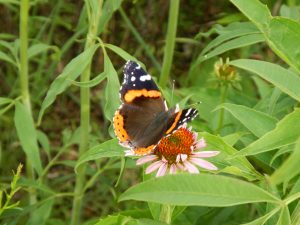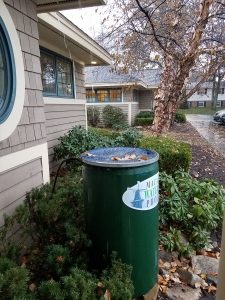By Carolyn Ulstad, Macatawa Area Coordinating Council
The days are getting warmer, the sun is setting later, and the tulips are starting to emerge from their long, cold sleep. Springtime is right around the corner, and I really couldn’t be any more ready for it.
 What I’m going to say next will sound utterly crazy to most of you, but I’ve really missed yard work. Yes, you read that correctly! I really enjoy mowing, pruning, and pulling weeds. My husband and I became first-time homeowners last year, so the thrill we get from taking care of our little patch of earth is still fresh!
What I’m going to say next will sound utterly crazy to most of you, but I’ve really missed yard work. Yes, you read that correctly! I really enjoy mowing, pruning, and pulling weeds. My husband and I became first-time homeowners last year, so the thrill we get from taking care of our little patch of earth is still fresh!
We decided early on that we wanted to manage our property in an Earth-friendly manner that would benefit our air, water, and soil. The practices I’m going to share with you are very simple and can be applied to any home or business.
Mowing: Annually in the U.S., it’s estimated that 5 percent of our air pollution comes from mowing, with Americans using around 580 million gallons of gas to cut grass. After moving, we purchased a human-powered reel-style mower. I feel good knowing that I’m not polluting the air or bothering the neighbors with the noise, and I get a decent workout! Electric mowers are good alternatives and have come a long way in terms of quality. If you do own a gas mower, keep the blades sharp and oil fresh. The more efficiently it runs, the less it will pollute.
 Fertilizer: Over time, standard fertilizer can have negative effects on groundwater and soil biology. After mowing, leave clippings on the grass; they will break down and become fertilizer for new growth. But keep the clippings off hard surfaces so they don’t end up in storm drains when it rains. This can lead to localized flooding and extra nutrients entering Lake Macatawa. Compost is another great form of fertilizer. Sprinkle it on your grass and plants. Compost piles are a great way to divert valuable food waste from the landfill.
Fertilizer: Over time, standard fertilizer can have negative effects on groundwater and soil biology. After mowing, leave clippings on the grass; they will break down and become fertilizer for new growth. But keep the clippings off hard surfaces so they don’t end up in storm drains when it rains. This can lead to localized flooding and extra nutrients entering Lake Macatawa. Compost is another great form of fertilizer. Sprinkle it on your grass and plants. Compost piles are a great way to divert valuable food waste from the landfill.
Herbicide: Using herbicides can potentially cause unintended harm to other plants or animals. There are a number of natural alternatives that can be explored, but hand pulling weeds is particularly satisfying!
 Rain barrel: Rainwater is free, and plants prefer it to tap water. Barrels also decrease the amount of water rushing into storm drains, reducing problems downstream.
Rain barrel: Rainwater is free, and plants prefer it to tap water. Barrels also decrease the amount of water rushing into storm drains, reducing problems downstream.
Native plants: Native plants typically require less water and maintenance because they are adapted to the local climate. Their deep roots help to store water underground, diverting and cleaning stormwater and recharging aquifers. They also provide critical habitat and food for native insects.
And finally, would you rather leave the work to the professionals? Then check out the Macatawa Area Coordinating Council’s lawn care company program at www.the-macc.org, under the Watershed/Urban Water Quality/Lawn Care pulldowns, to see which area companies have agreed to follow practices that protect Lake Macatawa’s water quality.
Carolyn Ulstad is the program assistant at the Macatawa Area Coordinating Council where she works to help the community address transportation and water quality issues. Carolyn is a life-long resident of Holland and member of the Holland Sustainability Committee.
![]() This Week’s Sustainability Framework Theme
This Week’s Sustainability Framework Theme
Environmental Awareness/Action: Environmental education and integrating environmental practices into our planning will change negative outcomes of the past and improve our future.
![]() ABOUT THIS SERIES
ABOUT THIS SERIES
Living Sustainably is a collection of community voices sharing updates about local sustainability initiatives. It is presented by the Holland-Hope College Sustainability Institute, a joint project of Hope College, the City of Holland and Holland Board of Public Works. Go to www.hope.edu/sustainability-institute for more information.

